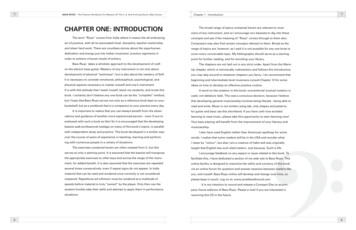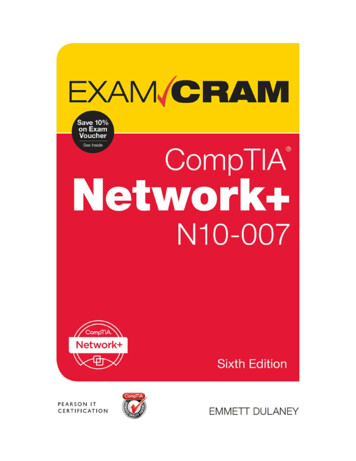
Transcription
BASS RIYAZ – The Practice Workbook For Mastery Of The 4, 5, And 6-string Electric Bass Guitar.CHAPTER ONE: INTRODUCTIONThe term “Riyaz” comes from India where it means the all-embracingThe broad range of topics contained herein are relevant to musicians of any instrument, and so I encourage non-bassists to dig into theseconcepts and see if the meaning of “Riyaz” comes through to them also.art of practice, with all its associated ritual, discipline, teacher-mentorshipComposers may also find certain concepts relevant to them. Broad as theand sheer hard work. There are countless stories about the superhumanrange of topics are, however, as I said it is not possible for any one book todedication and energy put into Indian musicians’ practice regiments incover every conceivable topic. My bibliography should serve as a startingorder to achieve virtuosic levels of artistry.point for further reading, and for enriching your library.Bass Riyaz takes a wholistic approach to the development of craftThe chapters are not laid out in any strict order. Apart from the Warmon the electric bass guitar. Mastery of any instrument is not only aboutUp chapter, which is intrinsically rudimentary and follows this Introduction,development of physical “technique”, but is also about the mastery of Self.you may skip around to whatever chapters you fancy. I do recommend thatIt is necessary to consider emotional, philosophical, psychological, andbeginning and intermediate level musicians consult Chapter 12 for somephysical aspects necessary to master oneself and one’s instrument.ideas on how to develop an effective practice routine.It is with this attitude that I teach myself, teach my students, and wrote thisA word on the notation in this book: conventional musical notation isbook. I certainly don’t believe any one book can be the “complete” method,used, not tablature (tab). This was a conscious decision, because I believebut I hope that Bass Riyaz serves not only as a reference book kept on yourthat developing general musicianship involves being literate - being able tobookshelf, but as a workbook that is a companion to your practice every day.read and write. Music is not written using tab, only shapes and patternsIt is important to realize that you can always benefit from the obser-for guitar and bass use this shorthand. If you have until now avoidedvations and guidance of another more experienced person - even if you’relearning to read music, please take this opportunity to start learning now!endowed with such a book as this! So it is encouraged that the developingYour bass playing will benefit from the improvement of your literacy andbassist seek professional tutelage on many of this book’s topics, in parallelmusicianship.with independent study and practice. This book developed in a similar way:I also have used English (rather than American) spellings for someover the course of years of experience in teaching, learning and perform-words. I realize that some readers will be in the USA and wonder whating with numerous people in a variety of situations.I mean by “colour”, but alas I am a creature of habit and was originallyThe exercises contained herein are often notated from C, but thisserves as only a starting-point. It is assumed that the bassist will transpose Chapter 1 - Introductiontaught that English has such silent letters. Just because. Such is life.I encourage feedback on any aspect or issue related to this book. Tothe appropriate exercises to other keys and across the range of the instru-facilitate this, I have dedicated a section of my web-site to Bass Riyaz. Thisment, for added benefit. It is also assumed that the exercises are repeatedonline facility is designed to maximize the utility and currency of this bookseveral times consecutively, even if repeat signs do not appear. In Indiavia an online forum for question-and-answer sessions between readers likematerial that can be read and rendered once correctly is not consideredyou, and myself. Bass Riyaz online will develop and change over time, somastered. Repetitions ad infinitum must be rendered at a multitude ofplease keep in touch. Log on to: www.jonathandimond.comspeeds before material is truly “owned” by the player. Only then can theIt is my intention to record and release a Compact Disc to accom-student humbly take their skills and attempt to apply them in performancepany future editions of Bass Riyaz. Please e-mail if you are interested insituations.receiving this CD in the future.
BASS RIYAZ – The Practice Workbook For Mastery Of The 4, 5, And 6-string Electric Bass Guitar.CHAPTER TWO: WARMING UPare given a chance to be involved in the process, not just your eyes. YouTuning Upyou tune.The fretted electric bass is equally tempered along each string,which means the 12 semitones per octave are of equal size. This tuningsystem allows for rapid and acceptable-sounding changes of keys, whichis required by most of the jazz, rock, and related contemporary musics forwhich the instrument is designed and mostly used. Intervals played acrossdifferent strings, however, may reveal slight intonation problems evenwhen the bass is considered “in tune”. This is due to a variety of reasons,including the physical condition of your bass and also acoustic phenomenawhich are introduced in Chapter 16, but whose details are outside of thescope of this book. You may also experience intonation variations whenplaying with other instruments, as they may not be using exactly the sametemperament or tuning system.There are three methods for effectively tuning your bass: with atuner; from a reliable reference; and/or using harmonics. Regardless ofthe method you choose, the process should be approached slowly andcarefully, so that you are tuned accurately. This approach also sets theright mood for the rest of your performance or practice. Tuning that is donehastily and as a mere formality does not give the ears and mind time tofocus on the sound you create. So again, take your time during tuning.Electronic TunerUsing an electronic tuner for the open strings results in a goodequally-tempered tuning, whereby the same notes on different stringsmatch as the manufacturer intended. Make sure your volume is fullyup when you plug into the tuner, and remember to turn the unit offafterwards. Note that for players of 5- or 6-string instruments, the low Bis below the range of most tuners, and tuning the 12th-fret harmonic isnecessary instead. Tuning any of the strings with 12th-fret harmonics willalways yield precisely the same result as tuning the open strings, as thenotes are a perfect octave higher. (See Chapter 16 for more information onharmonics.) For beginning and progressing bassists, I would suggest thatthis method be alternated or combined with the others so that your ears12Chapter 2 - Warming Upcould also plug in your amplifier to the tuner’s output to hear the strings asReference NoteTuning from a reference note involves the aural comparison of one ofyour strings with a reliable reference. This could be a note from the pianistor guitarist, if they’re tuned up! One possible reference is a tuning fork in E,A, D, or G. Touch it on the pickup and match the sound of the appropriatestring. Listen to whether the string is lower or higher than the referenceand turn the machine head accordingly. This is a skill that may take sometime but is worth developing. At first you may notice a tuning discrepancybut feel unsure as to whether the note being tuned is flat or sharpcompared to the reference. Listen for the oscillations in the compositesound as the two out-of-tune notes destructively interfere with each other.Take an educated guess and turn the tuning peg one direction (decreasingtension if the note seems sharp or increasing tension if it seems flat).Notice the change in speed of the oscillations - they slow down towards azero beat as the two pitches reach equality. If the oscillations accelerate,you’re moving in the wrong direction! Once one string is matched,the others can be matched from that string in one of two ways: usingharmonics (discussed below) or using fretted notes. The latter methodinvolves matching the open reference string against a fretted version of thesame note (or the same note an octave away) on the string to be tuned. Forexample, if you tuned your open G string, you can play that and comparethe 5th-fret G on the D string. Listen for the beating phenomenon again.HarmonicsThe most popular harmonic method usually involves comparingthe 5th-fret harmonic of one string with the 7th-fret harmonic of thestring above. These should produce the same note. The untuned stringis matched with the tuned one by making them zero beat in the samemanner as discussed above. Note that the harmonic method creates slightdiscrepancies with equal temperament, because the intonation of the notesof the harmonic series differs from equally-tempered notes. (The reasonsfor this are discussed in Chapter 16.). What this means is that each of your13
BASS RIYAZ – The Practice Workbook For Mastery Of The 4, 5, And 6-string Electric Bass Guitar.CHAPTER THREE:WORKING WITH A METRONOMEMuch debate occurs over the utility of a metronome. My recommendation is that since the electric bass is an instrument of both harmonic and timing reference for the rest of the ensemble, it is arequirement to have metronomic ability. This ability can be improved by working with a metronome ordrum machine. I prefer drum machines most of the time as they are far more flexible in their provisionof tempos, cyclical forms, various metres and subdivisions. (For programming drum machines, checkout the rhythm table at the end of the Glossary).The important thing to remember is not to use any kind of machine as a crutch: the device’spurpose is to help build your “internal clock” and to assist in mastery of techniques in the absence of aperfectly metronomic human practice partner! Get to know the device and then keep changing its rolein a creative manner. In this way, it will become creatively integrated into your practice, and there is nofear of over-reliancy. This chapter aims to provide “food for thought” in this respect.EXERCISE 3-1Walking bass line - Parker Blues in BbBb 7? b . 44bœ œ œ œq 120 ?. 44 œ¿œA-7b5D7b9œ œ #œœ¿œ¿œ¿œœ bœ bœ œEb7Eb-7? bb œ bœ œ œC7œœœnœG-7Ab7¿D-7œ œœœ bœ œ œF-7¿G7Bb7œ¿Db-7œ¿sim.Gb7bœ bœ bœ œœ nœA-7b5D7b9G-7C7F-7Bb7q 120 Bb 7œœœbœœ? b C-74#œœœnœ.F7Bb 7G-7C-7F7œœœb .4 œ œœ œœ? bb œ œ œ nœ œ œ œ œ œ œ œ œ œœ.sim.œ? .4 œ ¿ œ ¿œ ¿ œ ¿œ ¿ œ ¿œ ¿ œ ¿EXERCISE 3-1Walking bass line - Parker Blues in Bb.4first phrase one sixteenth-note prior to each click you hear. (Note that bars 2 and 4 will start with thissecond bar. Then keep the metronome at this slowest tempo and play only with the notes that coincide? b œ bœœ bœ bœ œ œ œœbœ bœ bœ œbœnœRedefiningtheclick4phaseseach beat). Then again - the click now shifts to the last. beat. One more. redefini. sixteenth-noteœœ. of artphase.Whenpracticingsuch. 4 œ œ œ œ œ .an exercise,andphrase to theC-7 subdivide in your head,F7 aim for even note-lengthsBb 7G-7try to segueC-7from oneF7? withoutœ œ œ œnexthavingto stopand œthink.œbœœnœ.œœœœœbœ? . 42 ¿œ.¿¿¿¿¿¿¿What you should start experiencing is a sense that each displaced version of the original has its .with the click; then twice per click; four times, eight times; etc. You are building the texture up again.own unique sound, but yet of course is also clearly derived from the original.For example, begin by practicing a walking bass line with the metronome clicking every beat (seeExercise 3-1). Then try changing the metronome to half the tempo, and define those beats as 2 and 4.(These are notated as crossed note-heads.) Then try defining those beats as 1 and 3. (These are notatedas regular note-heads.) Then try halving it again and defining the click as the downbeat (beat 1) of eachbar. Redefine it as beat 2 of each bar. Then try halving it again and defining it as the downbeat of everyImagine the notes that you are not playing. The strategy here is to practice systematically “weaning”yourself off the metronome, so that you have to rely on your internal clock. Even this simple exercisecan take quite some time to perfect.In summary, the concept here is to use a metronome to click on the whole rhythmic spectrum- from individual subdivisions/pulses through to downbeats of multiple-bar phrases.This previous exercise illustrates the need to be flexible in your ability to “define” what the clickis articulating. We all know how lost we can feel when we listen to music and don’t know where beat“1” is, or we think we do and then are told that it’s actually elsewhere! To bridge to the new perspectivetakes flexibility and strength - we have to be able to leave our initial definition and grasp the new one.Players skilled in this area are able to play with syncopation in such a way that the form of a piece canbecome completely ambiguous and yet they know “where it is”.Exercise 3-2 is a redefinition exercise to further illustrate this point. It starts with a 2/4 click and a4-bar cycle with a latin feel. Begin at 60 b.p.m. (beats per minute). Then define the same click not as thebeat but as quarter notes starting on the second sixteenth-note. This means that you have to start your50Chapter 3 - Working With A MetronomeEb7Eb-7Ab7D-7G7Db-7Gb7displaced click.) Then redefine the beat again - theclick now3-2shifts to the off-beats (one eighth note afterEXERCISE? . 42 ¿ .J ¿.J.‰œ œ ¿œ œ ‰œ. ¿œJJRedefining the click - 4 phases? .4242? . 4242 ‰¿.¿ ‰¿.R? . 42 ¿ .J? . 42 ‰? . 42 ‰.¿R ¿.J¿J‰¿ ‰.R ¿.J ¿. ¿.JEXERCISE 3-2J‰ . .œ ¿œ œ ‰œ œ¿‰¿.¿ ‰¿.RJ ¿.J¿J‰¿R‰.J‰¿ ‰.R ¿.J. œ.œœ‰ œ œ¿ œ ‰ ¿J¿R ¿.J¿J ¿.J¿‰. ¿.J¿J‰¿R‰.¿R ¿.J¿J‰¿ ‰.R. œ. .œœœœ ‰ ¿J ‰ ¿J .J¿ ¿‰.R ¿.J¿‰.¿ ¿‰.R ¿.J¿J‰¿R‰.¿ .R ¿.J¿J‰¿ ‰.R.¿J.¿ .R51
BASS RIYAZ – The Practice Workbook For Mastery O
BASS RIYAZ – The Practice Workbook For Mastery Of The 4, 5, And 6-string Electric Bass Guitar. Chapter 1 - Introduction CHAPTER ONE: INTRODUCTION The term “Riyaz” comes from India where it means the all-embracing art of practice, with all its associated ritual, discipline, teacher-mentorship











